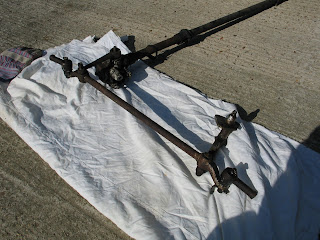When an attempt was made to remove the bush at the end of the steering arm, no amount of persuasion, gentle or otherwise, was successful despite the use of a variety of tools that should have done the trick. The next option was to remove the steering arm from the steering box shaft that is splined and conical.
The question was, was removal of the arm necessary? The answer had to be 'yes' because the arm position did not allow the steering wheel to be aligned correctly unless the track rods were adjusted to have unbalanced lengths. This imbalance was about 0.75 inches (about 20mm) and did not follow the Fairthorpe guidelines of being of an equal length although we have since learned that none of the EMs achieved such a result! The length imbalance can be seen below.
It is obvious that unbalanced track rod lengths will affect the steering lock and so the decision had to be - remove the steering arm and then it can be replaced in such an angular postion that track rod length balance can be achieved.
Like the bush that could not be removed, the steering arm refused to budge and so the decision was made to seek the services of a local motor engineering firm having a good reputation as well as the requisite equipment. The complete steering assembly was removed and then returned with all bushes and the arm removed.
Problem solved? Yes and no because removal of the arm revealed that the shaft/arm junction was not a simple splined cone that would have allowed an incremental angular adjustment of the arm but also included four wider and deeper splines that effectively limited angular adjustment to 90 degrees thus giving only one position that was useable.
Two of the four splines can be seen on the image, one in line with the hole on the threaded part of the shaft and the second 90 degrees clockwise from it.






